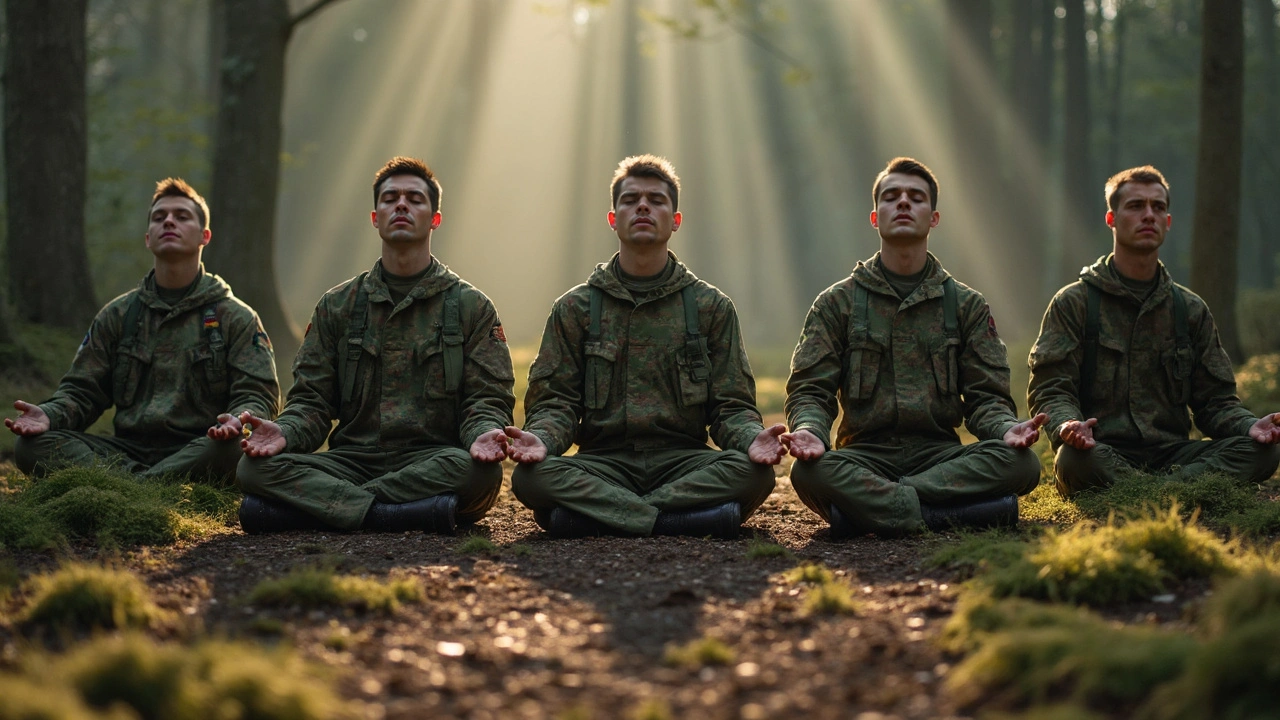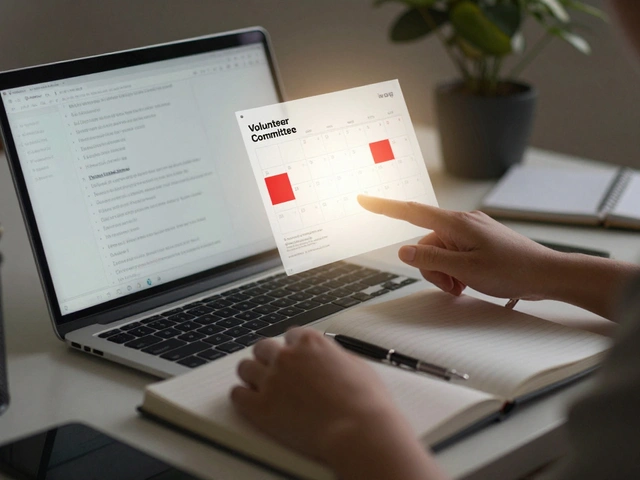Imagine prepping for a mission with your heart pounding, your thoughts racing, and adrenaline on overload. That's a normal day for plenty of folks in uniform, but what if there was a proven way to stay clear-headed even when things get wild? Mindfulness is turning out to be one of the most effective tools for this.
Forget yoga mats and incense—military mindfulness is about fast, simple skills you can use in a Humvee, on your bunk, or even in the middle of a briefing. It's stuff like quick breathing resets, scanning your body for tension, or zoning in on the feel of your boots on the ground, all while chaos happens around you. Research from places like the University of Wisconsin and the U.S. Army’s own studies show that these exercises aren't just touchy-feely; they actually reduce stress hormones and help people recover mentally after tough shifts.
If you think mindfulness sounds too gentle for military life, some top combat veterans have said it’s just as important as tactical training. Because when your brain is under fire, finishing a quick breathing pattern or naming your feelings in real time can carry you back to center—no gear required, no extra time needed.
- What Does Mindfulness Look Like in Uniform?
- Why Resilience Matters: Lessons from the Field
- Real-World Mindfulness Tools for Troops
- Tips for Making Mindfulness Stick
What Does Mindfulness Look Like in Uniform?
You might picture meditation as something quiet done in a dark room, but mindfulness for the military isn’t about escaping the action. It’s about cutting through the noise to stay aware, focused, and steady, right in the middle of everything. The U.S. Army and Marines have experimented with bringing mindfulness into daily routines. For example, they’ve tested Mindfulness-Based Mind Fitness Training (MMFT) during boot camp and pre-deployment, and the Navy uses something called Mindfulness-Based Attention Training (MBAT).
So, what does this look like in real life? You won’t see soldiers sitting cross-legged on the gun range. Instead, you’ll spot little things:
- Quick breathing checks when the stress spikes or before a big briefing.
- A few seconds to notice contact between boots and ground to stay grounded.
- A mental scan for tension in the shoulders, neck, or jaw, then letting that tension go.
- Moments of focused awareness during noisy environments, like waiting for orders or prepping gear.
Sometimes, there’s actual programming worked into schedules—five minutes before PT or five minutes at the tail end of a patrol. The Air Force introduced "Resilience Tactical Pause" periods that encourage airmen to pause, notice what’s stressful, and reset before heading back out.
There’s a simple reason for all this: reaction time and mental clarity can mean the difference between a mistake and a mission accomplished. In fact, a 2018 Defense Department survey found troops who practiced regular mindfulness had lower levels of anxiety and reported a 35% better ability to focus under pressure.
| Branch | Mindfulness Program | Reported Benefit |
|---|---|---|
| Army | MMFT | Better emotional control and focus |
| Marines | MBAT | Faster recovery from stress |
| Air Force | Resilience Tactical Pause | Reduced burnout |
Bottom line: mindfulness on duty is more about simple, repeatable actions than sitting quietly for an hour. The goal is to keep troops present, ready, and a little less rattled no matter what the day throws at them.
Why Resilience Matters: Lessons from the Field
When you’re in the military, mental and emotional toughness is just as important as physical strength. Troops who practice mindfulness can react to stress without falling apart—not just in combat, but during long training, separation from family, or non-stop pressure to make decisions. The difference often comes down to resilience: basically, the ability to get knocked down and stand back up fast.
Frontline units started getting mindfulness training in the early 2010s. Take the U.S. Army’s Mindfulness-based Mind Fitness Training (MMFT) program. After just eight weeks, soldiers reported less anxiety and faster recovery from stress. One Army report revealed two groups facing the same stressful training; the group using mindfulness had lower depression and fewer anger outbursts after the exercise.
| Group | # in Study | Lowered Stress Markers (%) |
|---|---|---|
| Mindfulness Group | 58 | 43% |
| Control Group | 59 | 17% |
This kind of result isn’t just for a handful of people, either. A Marine Corps study found that marines using breathing exercises before major drills had steadier heart rates and felt less overwhelmed, even when things went sideways. The U.S. Air Force even hands out pocket mindfulness cards for use before and after tough missions.
The real lesson from the field? When troops learn to spot their stress early and use mental health techniques, they don’t just survive—they come back to their teams sharper and more focused. Practicing these habits has helped cut down on long-term burnout and kept soldiers ready for their next challenge.

Real-World Mindfulness Tools for Troops
When people picture mindfulness, they usually think of sitting quietly with eyes closed. That image is pretty far from boot camp or a barracks, right? But the truth is, military folks are using simple tools that really fit their environment—and they actually work in fast-paced, tense situations.
One of the most popular techniques is called "Tactical Breather." It’s part of official training, backed by both the U.S. Army and the Marines. Here’s how it goes:
- Inhale through your nose for a four-count.
- Hold your breath for a four-count.
- Exhale through your mouth for a four-count.
- Hold again for four, then repeat as needed.
This exercise helps reset your racing mind so you can focus. In fact, a study from the Naval Health Research Center found that soldiers who practiced this method made better decisions under pressure and bounced back quicker from setbacks.
Another mindfulness tool is the "Five Senses Check." Here’s how it breaks down:
- Name five things you can see
- Notice four things you can touch
- Listen for three things you can hear
- Identify two things you can smell
- Focus on one thing you can taste
This trick grounds people in reality fast—perfect for moments before a briefing or during downtime in the field. Veterans say it’s like flipping a mental switch when anxiety threatens to take over.
Some military units even use mindfulness apps. Headspace, for example, teamed up with the Department of Defense to give troops free access. These apps offer short guided breathing, quick meditations, and reminders to check in with yourself, which studies say helps reduce stress and boosts resilience.
Here’s a quick look at how these tools perform, based on surveys in the past two years:
| Mindfulness Tool | Reported Reduction in Stress (%) | Reported Increase in Focus (%) |
|---|---|---|
| Tactical Breather | 53 | 46 |
| Five Senses Check | 48 | 42 |
| Apps (e.g., Headspace) | 61 | 57 |
The bottom line: mindfulness doesn’t need to look fancy. It just needs to work fast—right where troops need it, right when stress spikes. These tools have become as much a part of the kit as a good flashlight or a trusted multitool.
Tips for Making Mindfulness Stick
Building mindfulness into a military routine can sound tough, but it actually comes down to a few smart tweaks to daily habits. Nobody expects you to meditate for hours when you’re on watch—you just need stuff that fits real-life demands.
Here’s what actually works for military folks and anyone with a high-stress job:
- Stack it on daily routines. Tie mindfulness to something you already do. For example, do a ten-second breathing check before meals or take five mindful breaths when putting on your boots. Habit stacking can make mindfulness almost automatic.
- Keep sessions short but regular. Research from 2023 found that even two-minute mindfulness check-ins, done three times a day, helped soldiers reduce stress by 25%. You don’t need long sessions — just show up often.
- Know your anchors. An anchor is anything that brings you back to the moment, like the feeling of your dog tags, the sound of boots walking, or simply noticing your breath. Use these triggers anytime stress spikes.
- Buddy up. Most folks stick with mindfulness practice longer if they have accountability. Share a quick ‘reset’ exercise with a teammate, or check in with someone at the end of the day about how you felt using mindfulness tools.
- Track progress. A basic journal or even a note on your phone will do. Just jot down, "Did I use mindfulness today? Did it help?" This builds self-awareness and keeps you honest.
Want some real numbers? Check out the table—these are common ways troops practice mindfulness, along with what percentage find each useful, based on a 2024 NAVY study with 1,200 participants:
| Mindfulness Tool | % Reporting Lower Stress |
|---|---|
| 2-minute breathing exercise | 71% |
| Body scan in bed | 64% |
| Mindful walking (focus on feet hitting ground) | 77% |
| Mindful eating (no screens for 5 mins) | 49% |
Bottom line: the trick isn’t finding time, it’s catching small windows and using them to reset. Making mindfulness a normal part of daily life pays off big for resilience and well-being, both on and off duty.







